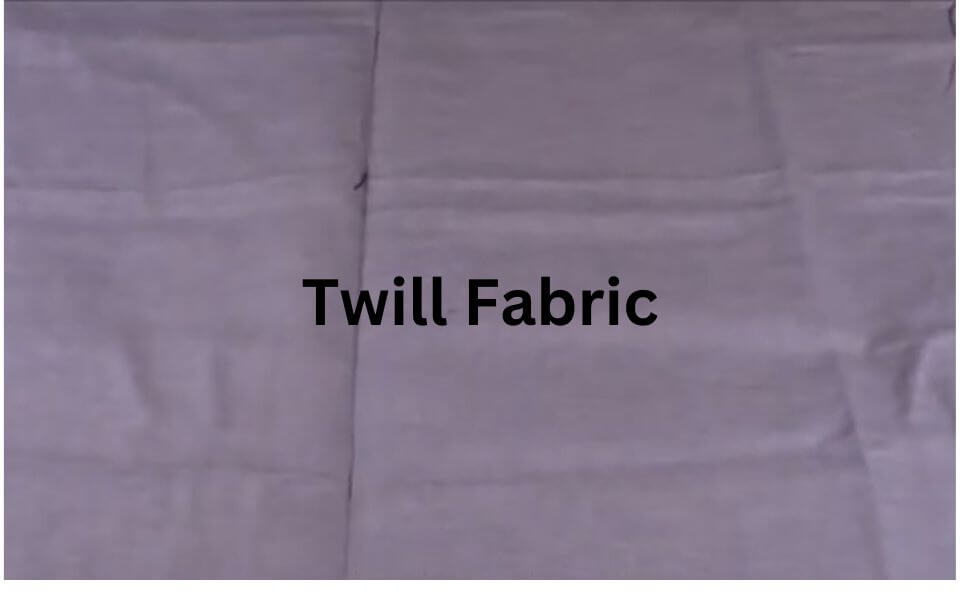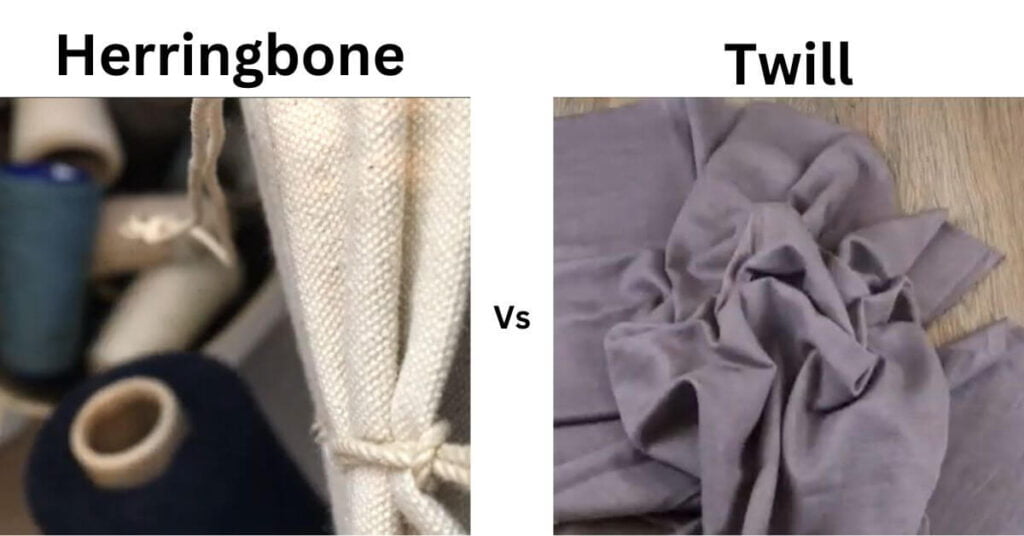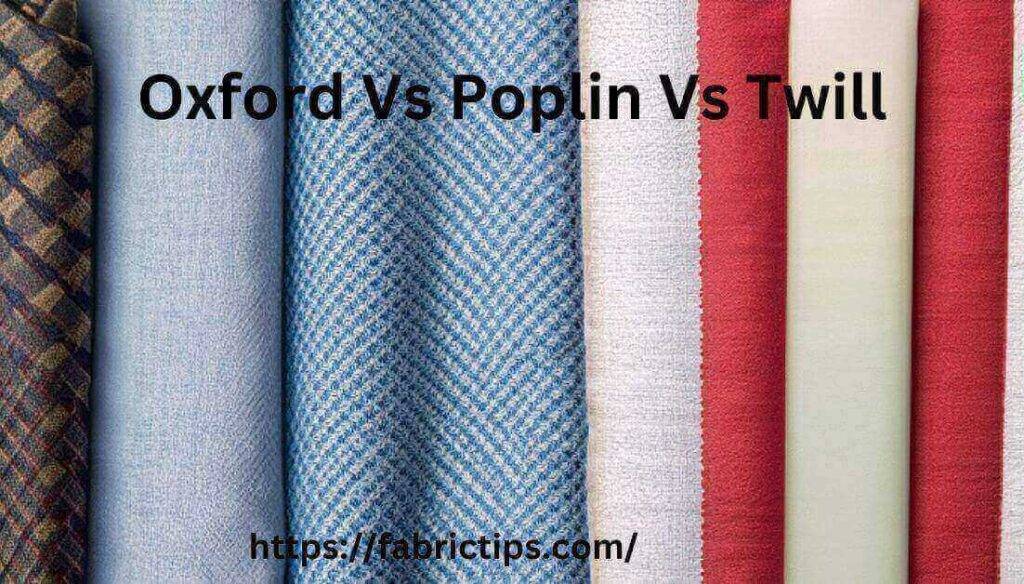Last Updated on June 14, 2024 by Wahid
Ever wondered what makes herringbone and twill fabrics so popular and versatile? Both showcase a diagonal weave pattern, but are there key differences to consider? The answer is yes! While they share some similarities, herringbone & twill have distinct characteristics that influence their drape, durability, and ideal uses. This comprehensive guide dives deep into the world of herringbone vs twill, equipping you with the knowledge to make informed fabric choices for your next project.
Head-to-Head Comparison: Herringbone vs Twill
| Feature | Herringbone | Twill |
| Weave Pattern | Broken twill weave creating a distinct zigzag or fishbone pattern. | Diagonal weave with a continuous line. |
| Appearance | More pronounced texture with a defined V-shape. | Smoother texture with a subtle diagonal line. |
| Drape | Varies depending on weight; heavier fabrics drape well, lighter ones drape more loosely. | Generally drapes well, offering a structured look. |
| Durability | Highly durable, ideal for everyday wear. | Ranges from lightweight & breathable to strong, depending on the weave and fiber content. |
| Common Uses | Suits, jackets, trousers, coats, bags, hats. | Pants, shirts, jackets, dresses, bags, upholstery. |
What is Herringbone Fabric?

Herringbone, also known as chevron, is a type of twill weave distinguished by its broken diagonal pattern. The weave creates a series of interlocking V-shapes that resemble the bones of a herring fish, hence the name. Thus, this unique pattern adds visual texture and dimension to fabrics, making them visually appealing & perfect for statement pieces.
What is Twill Fabric?

Twill is a fundamental weave structure featuring diagonal lines formed by weaving yarns over several warp threads (vertical threads) before going under one or two. This creates a subtle diagonal texture that adds a touch of sophistication & dimension to fabrics. Twill fabrics come in a wide variety of weights and fiber blends, offering versatility for various clothing & textile applications.
Types of Herringbone and Twill Fabrics
- Herringbone:
- Houndstooth: A classic black and white herringbone pattern with a sharp & eye-catching appearance.
- Tweed: A heavier herringbone fabric often made from wool, known for its warmth & durability.
- Shepherds Check: A black & white herringbone pattern with larger checks, ideal for outerwear.
- Twill:
- Denim: A sturdy twill fabric typically made from cotton, known for its iconic blue color & durability.
- Chino: A lighter-weight twill fabric often made from cotton, offering a comfortable & versatile option for pants.
- Gabardine: A tightly woven twill fabric with a smooth surface, often used for workwear and outerwear.
Benefits & Drawbacks of Herringbone and Twill Fabrics
Both herringbone and twill fabrics are popular choices for clothing and home decor due to their durability and versatility. However, each has its own set of advantages and disadvantages to consider when selecting the perfect material for your project.
Benefits of Herringbone Fabric:
- Visual Interest & Texture: Herringbone’s distinct V-shaped pattern adds a touch of sophistication and dimension to any project. This makes it a great choice for creating statement pieces that stand out.
- Drape: Depending on the weight of the fabric, herringbone can drape beautifully. Lighter weights offer a more fluid drape, while heavier weights provide a structured look.
- Durability: Herringbone fabrics, particularly those made from natural fibers like wool, are known for their strength and resilience, making them ideal for garments or upholstery that will see regular use.
- Warmth: Heavier herringbone fabrics, especially those made from wool, provide excellent insulation, making them a great choice for winter clothing or cozy throws.
Drawbacks of Herringbone Fabric:
- Wrinkles: Some herringbone fabrics, particularly lighter weights, can be prone to wrinkling. This might require more frequent ironing or steaming.
- Limited Color Options: While herringbone comes in a variety of colors, it’s not as widely available in a vast color palette as some other fabrics.
- Cost: Depending on the fiber content and quality, herringbone fabrics can sometimes be more expensive than twill.
Benefits of Twill Fabric:
- Versatility: Twill comes in a wide range of weights and textures, making it suitable for a vast array of projects. From lightweight & breathable fabrics like chinos to sturdy denim and luxurious gabardine, twill offers options for all seasons and needs.
- Drape: Twill fabrics generally drape well, offering a structured yet comfortable look. This makes them ideal for a variety of clothing styles and home decor applications.
- Durability: Depending on the weave and fiber content, twill fabrics can be highly durable & long-lasting. Denim, for example, is renowned for its strength, while gabardine offers excellent wrinkle resistance.
- Color Options: Twill is readily available in a vast array of colors and patterns, making it easy to find the perfect match for your project.
Drawbacks of Twill Fabric:
- Subtle Texture: Compared to herringbone, twill’s diagonal texture is more subtle. While this adds a touch of sophistication, it might not be the best choice if you’re looking for a fabric with a bolder visual statement.
- Breathability: Heavier twill fabrics, like denim, can be less breathable and might not be ideal for hot weather wear.
- Care Requirements: Some twill fabrics, like gabardine, might require specific care instructions to maintain their wrinkle resistance.
Yes, both twill & herringbone fabrics offer a unique combination of style and functionality. By understanding their individual strengths and weaknesses, you can make an informed decision about which fabric best suits your project needs. Consider the desired visual impact, weight, drape, and care requirements when making your selection.
Herringbone & Twill: A World of Applications

Herringbone and twill fabrics, with their durability and distinct aesthetics, find themselves woven into a wide variety of applications. Let’s explore the diverse uses of these versatile textiles:
Herringbone’s Sophisticated Touch:
- Clothing: Herringbone shines in the realm of outerwear and tailored garments.
- Suits and jackets: The structured drape and visual interest of herringbone make it a classic choice for suits and blazers, adding a touch of sophistication to formal attire.
- Trousers and skirts: Herringbone trousers offer a timeless and polished look, while skirts made from this fabric can be both elegant and comfortable.
- Coats: Winter coats crafted from heavier herringbone fabrics provide warmth and style.
- Accessories: Herringbone’s visual texture elevates accessories like:
- Bags: Totes, briefcases, & clutches made from herringbone exude a professional and stylish air.
- Hats: Herringbone newsboy caps or fedoras add a touch of vintage charm.
- Home Decor: Herringbone adds a touch of warmth and texture to home furnishings:
- Throws and pillows: Herringbone throws draped over a couch or decorative pillows can add a cozy and inviting feel to a living space.
- Upholstery: Herringbone furniture upholstery, particularly for armchairs or ottomans, creates a sophisticated and timeless look.
Twill’s Versatile Appeal:
- Clothing: Twill’s adaptability makes it a mainstay in various clothing applications:
- Pants: From classic chinos to sturdy denim jeans, twill offers a range of options for comfortable & stylish pants.
- Shirts: Twill shirts, like chambray shirts, offer a casual yet put-together look.
- Dresses: Twill dresses can be light & breezy for summer or heavier for cooler seasons, depending on the fabric weight.
- Jackets: Twill jackets, like denim jackets or bomber jackets, are a timeless staple in many wardrobes.
- Accessories: Twill’s durability makes it perfect for various accessories:
- Bags: From everyday backpacks to tote bags, twill offers a sturdy and stylish option.
- Hats: Baseball caps and bucket hats are commonly made from twill.
- Home Decor: Twill finds its way into numerous home decor applications:
- Upholstery: Twill upholstery is a popular choice for furniture pieces like couches, chairs, and ottomans due to its durability and stain resistance.
- Curtains & blinds: Twill curtains offer a touch of texture & can provide light filtering or blackout capabilities depending on the weave.
- Tablecloths and napkins: Twill tablecloths and napkins add a touch of casual elegance to a dining table.
Beyond the List:
This list provides a starting point, but the possibilities for herringbone and twill extend far beyond. From crafting projects like tote bags or hats to workwear uniforms and even artistic applications, the versatility of these fabrics allows for endless creative exploration.
Remember, the ideal use for each fabric depends on factors like weight, fiber content, and desired outcome. So, unleash your creativity & explore the vast world of herringbone and twill!
Similarities & Differences: Herringbone vs Twill Fabric
Both herringbone and twill fabrics are weaving techniques that create diagonal lines on the surface of the material. They share some key characteristics, but also have distinct features that influence their appearance, drape, and applications.
Similarities:
- Durability: Both herringbone and twill are known for their strong and resilient construction, making them ideal for garments and homewares that will see regular use.
- Versatility: Both fabrics come in a variety of weights and fiber blends, offering options for different seasons and styles.
- Drape: Generally, both fabrics drape well, providing a structured yet comfortable look. This makes them suitable for a variety of clothing styles and home decor applications.
- Weave Foundation: Herringbone is a type of twill weave, meaning they share the basic diagonal structure as their foundation.
Differences:
- Weave Pattern: Here lies the key distinction:
- Herringbone: Features a broken twill weave, creating a distinct V-shape or zigzag pattern with a more pronounced texture.
- Twill: Showcases a continuous diagonal weave resulting in a subtler, uniform line.
- Appearance:
- Herringbone: Offers a bolder visual statement due to its pronounced V-shape.
- Twill: Provides a more subtle & sophisticated look with its diagonal lines.
- Wrinkle Resistance:
- Herringbone: Some lighter-weight herringbone fabrics can be more prone to wrinkles.
- Twill: Certain twill weaves, like gabardine, offer superior wrinkle resistance.
- Color Options:
- Herringbone: While available in various colors, it might not boast as wide a color palette as twill.
- Twill: Generally offers a wider range of colors and patterns.
Choosing Between Herringbone and Twill:
The best choice depends on your project’s specific needs & desired aesthetic:
- For a bold visual statement and a touch of texture: Choose herringbone.
- For a more subtle, sophisticated look: Opt for twill.
- For projects requiring wrinkle resistance: Consider heavier twill weaves like gabardine.
- If a vast color selection is crucial: Twill might be the better option.
Now, by understanding these similarities and differences, you can effectively select between twill and herringbone fabrics for your next project, ensuring the chosen material complements both the function and the desired style.
Herringbone vs Twill: Who is the Winner? And why?
There’s no clear winner in the battle of herringbone vs twill! Both fabrics boast unique advantages and applications. The best choice truly depends on your specific project needs and desired aesthetic. Here’s a breakdown to help you decide:
Choose Herringbone if:
- You want a fabric with a distinctive visual texture and a bolder look.
- The project benefits from a structured drape (think tailored jackets or structured throws).
- Warmth is a priority, especially when using heavier herringbone fabrics made from wool.
Choose Twill if:
- You prefer a more subtle and sophisticated look with a hint of texture.
- Versatility is key, as twill comes in a wider range of weights and colors to suit various needs.
- Wrinkle resistance is a major concern (certain twill weaves like gabardine are excellent in this aspect).
- A vast color palette is crucial for your project.
Ultimately, the winner is the fabric that best compliments your vision and project requirements. Consider these factors when making your decision:
- Desired Look: Do you want a bold statement piece or a more understated look?
- Project Requirements: Does the project require warmth, wrinkle resistance, or a specific drape?
- Material Needs: What weight and fiber content best suits your project?
- Personal Preference: Do you gravitate towards a more classic herringbone or the versatility of twill?
Remember: Both herringbone and twill are excellent choices for various applications. Experiment with both to discover which fabric speaks to your creative vision!
FAQs
Question-01: Is herringbone the same as twill?
Answer: Herringbone is a type of twill weave, but with a distinct variation. Twill has a continuous diagonal line, while herringbone features a broken twill weave creating a V-shape or zigzag pattern.
Question-02: Which fabric is more durable, herringbone or twill?
Answer: Both fabrics are known for their durability. However, specific factors like fiber content and weave tightness can influence strength. Generally, heavier weights of both herringbone & twill offer superior durability.
Question-03: Is herringbone fabric warm?
Answer: Yes, especially heavier herringbone fabrics made from wool. The interlocking V-shape traps air, providing excellent insulation.
Question-04: Does twill wrinkle easily?
Answer: It depends on the twill weave. Some lighter twills might wrinkle more easily, while tighter weaves like gabardine offer good wrinkle resistance.
Question-05: What kind of clothes are made from herringbone?
Answer: Herringbone is commonly used for suits, jackets, trousers, coats, & even winter accessories like hats and scarves.
Question-06: What’s the difference between herringbone and houndstooth?
Answer: Houndstooth is a specific black and white check pattern created with a broken twill weave, making it a type of herringbone with a distinct visual identity.
Question-07: Is twill a good fabric for dresses?
Answer: Absolutely! Twill comes in various weights, making it suitable for different dress styles. Lighter twills are perfect for summer dresses, while heavier twills can be ideal for fall and winter dresses.
Question-08: Can you wash twill or herringbone fabric?
Answer: Yes, but washing instructions depend on the fiber content. Always check the care label for specific guidelines. Generally, machine washing on a gentle cycle with cold water is recommended for many twill and herringbone fabrics.
Question-09: Is herringbone fabric expensive?
Answer: The cost can vary depending on the fiber content and quality. Herringbone fabrics made from natural fibers like wool might be more expensive than some twills.
Question-10: Which fabric is better for upholstery, herringbone or twill?
Answer: Both can be good choices for upholstery, depending on the specific needs. Heavier herringbone and twill weaves offer good durability for furniture pieces. Consider factors like stain resistance and desired aesthetic when making your decision.
Question-11: How can I tell the difference between herringbone and twill fabric?
Answer: Look closely at the weave pattern. Herringbone has a distinct V-shape or zigzag, while twill has a continuous diagonal line. Run your fingers across the fabric; herringbone will feel slightly more textured due to the broken twill weave.
Conclusion: Herringbone vs Twill
The journey through the world of herringbone vs twill fabrics hopefully equips you to make informed choices for your next project. While both share the foundation of a diagonal weave, their distinct characteristics offer unique advantages.
Herringbone, with its pronounced V-shape pattern, adds a touch of drama and texture, making it ideal for statement pieces and projects that benefit from a structured drape. Twill, on the other hand, provides a more subtle sophistication with its diagonal lines. Its versatility in weight, color options, and wrinkle resistance makes it a popular choice for a wide range of applications.
There’s no single winner! Hence, champion is the fabric that best compliments your vision and project needs. Consider the desired aesthetic, project requirements, material needs, & even your personal style preference when making your selection.
So, unleash your creativity! Happy crafting!


